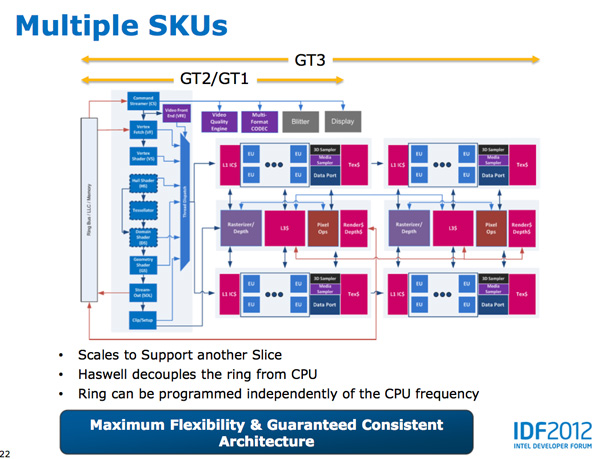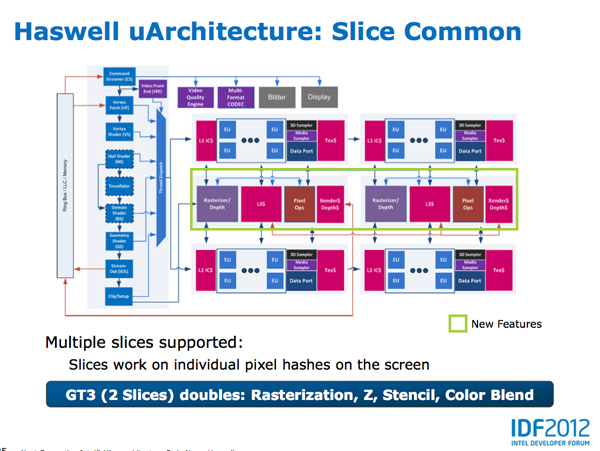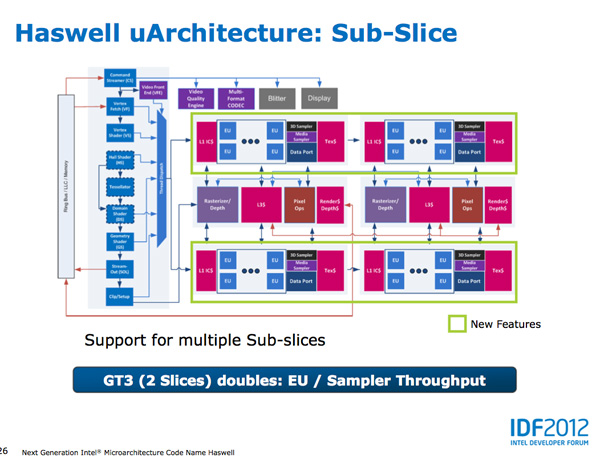Intel's Haswell Architecture Analyzed: Building a New PC and a New Intel
by Anand Lal Shimpi on October 5, 2012 2:45 AM ESTHaswell's GPU
Although Intel provided a good amount of detail on the CPU enhancements to Haswell, the graphics discussion at IDF was fairly limited. That being said, there's still some to talk about here.
Haswell builds on the same fundamental GPU architecture we saw in Ivy Bridge. We won't see a dramatic redesign/re-plumbing of the graphics hardware until Broadwell in 2014 (that one is going to be a big one).
Haswell's GPU will be available in three physical configurations: GT1, GT2 and GT3. Although Intel mentioned that the Haswell GT3 config would have twice the shader count of Haswell GT2, it was careful not to disclose the total number of EUs in any of the versions. Based on the information we have at this point, GT3 should be a 40 EU configuration while GT2 should feature 20 EUs. Intel will also be including up to one redundant EU to deal with the case where there's a defect in an EU in the array. This isn't an uncommon practice, but it does indicate just how much of the die will be dedicated to graphics in Haswell. The larger of an area the GPU covers, the greater the likelihood that you'll see unrecoverable defects in the GPU. Redundancy at the EU level is one way of mitigating that problem.
Haswell's processor graphics extends API support to DirectX 11.1, OpenCL 1.2 and OpenGL 4.0.
At the front of the graphics pipeline is a new resource streamer. The RS offloads some driver work that the CPU would normally handle and moves it to GPU hardware instead. Both AMD and NVIDIA have significant command processors so this doesn't appear to be an Intel advantage although the devil is in the (unshared) details. The point from Intel's perspective is that any amount of processing it can shift away from general purpose CPU hardware and onto the GPU can save power (CPU cores go to sleep while the RS/CS do their job).
Beyond the resource streamer, most of the fixed function graphics hardware sees a doubling of performance in Haswell.
At the shader core level, Intel separates the GPU design into two sections: slice common and sub-slice. Slice common includes the rasterizer, pixel back end and GPU L3 cache. The sub-slice includes all of the EUs, instruction caches and EUs.
In Haswell GT1 and GT2 there's a single slice common, while GT3 sees a doubling of slice common. GT3 similarly has two sub-slices, although once again Intel isn't talking specifics about EU counts or clock speeds between GT1/2/3.
The final bit of detail Intel gave out about Haswell's GPU is the texture sampler sees up to a 4x improvement in throughput over Ivy Bridge in some modes.
Now to the things that Intel didn't let loose at IDF. Although originally an option for Ivy Bridge (but higher ups at Intel killed plans for it) was a GT3 part with some form of embedded DRAM. Rumor has it that Apple was the only customer who really demanded it at the time, and Intel wasn't willing to build a SKU just for Apple.
Haswell will do what Ivy Bridge didn't. You'll see a version of Haswell with up to 128MB of embedded DRAM, with a lot of bandwidth available between it and the core. Both the CPU and GPU will be able to access this embedded DRAM, although there are obvious implications for graphics.
Overall performance gains should be about 2x for GT3 (presumably with eDRAM) over HD 4000 in a high TDP part. In Ultrabooks those gains will be limited to around 30% max given the strict power limits.
As for why Intel isn't talking about embedded DRAM on Haswell, your guess is as good as mine. The likely release timeframe for Haswell is close to June 2013, there's still tons of time between now and then. It looks like Intel still has a desire to remain quiet on some fronts.














245 Comments
View All Comments
Penti - Saturday, October 6, 2012 - link
Also FPU/SIMD has been a large part in later ARM designs and implementations. It's really a big deal as we saw with the chips lacking some of those parts. You shouldn't forget how important those bits are. Others have failed because they didn't take it seriously. That was 15-20 years ago even. Doesn't mean they are yet fighting x86-64 chips in high-end servers and workstation though. We will certainly see them entering that market by 2015 though.Arbee - Friday, October 5, 2012 - link
Cortex A9's big IPC improvement came from going out-of-order, which kind of ruins your argument.Similarly, the X360/PS3 PowerPC chips are strict in order and super ultra slow as a result - at 3.2 GHz they can't match a PowerMac G5 with out-of-order at 2.2 GHz. But I suspect that wasn't the point - Sony and MS can claim the eye-popping (in 2006) 3.2 GHz figure, and the heat production is certainly less than a PPC G5.
wumpus - Friday, October 5, 2012 - link
Has anyone seen an A9 in the wild? I don't doubt huge IPC improvements (back when O-O-O was new, it tended to double performance). My statement is that it will kill GIPS/W and that Intel can much more easily design a chip that can beat it in both raw performance and GIPS/W (note that your mention of heat production agrees with me).Also note I suspect that the goal of A9 is to keep the power low enough to keep it out of where Intel wants to go. A rough guess is that ARM might have a chance with dual issue o-o-o, but past that (roughly where Pentium Pro was designed) they can't really go.
ElvenLemming - Friday, October 5, 2012 - link
The Cortex A9 has been in most major phone/tablet SoCs for the past two or so years. Apple's A5, A5X; Samsung's Exynos 4210, 4212, 4412; TI's OMAP 4 series; Nvidia's Tegra 2 and 3.Cortex A15 is probably what you were thinking of that we've yet to see out in the wild. It's out-of-order like the A9, but with a great deal of other improvements.
ericore - Friday, October 5, 2012 - link
Currently AMD has the upper hand on the notebook segment on battery life. Haswell changes that, but as is always the case with Intel, they will be pricey. And that's why AMD will still have 50% of the market because vendors are cheap.Power savings are much less relevant on desktop front; I don't care so much about power as i do of heat. AMD X4 700, ship an awsome 4 core cpu for 75$. Technically, it has all that you need from a CPU. Add a Radeon 7770 (again cheap) and your golden. Ya Intel is faster, but both Intel and Nvidia have shitty low end products and that's even more true when you think of atom. 5-15% single threaded performance is not anything that is going to burry AMD lol.
On top of that, AMD has an atom KILLER, a contracts with all major console vendors.
Haswell will have surprisingly little impact on AMD; what I am saying is if you look at your own expectations, you'll realize they were highly inflated and you'll wonder why it didn't do more damage to AMD. I've explained the why. Nevertheless broadwell is a significant threat, and we'll probably see AMD start to lose market share (much more than with haswell) unless AMD can fight back and it will; but nobody knows if it will be enough.
A5 - Friday, October 5, 2012 - link
Uh, wow.Zink - Saturday, October 6, 2012 - link
http://www.tomshardware.com/reviews/gaming-cpu-rev...tipoo - Friday, October 5, 2012 - link
"Overall performance gains should be about 2x for GT3 (presumably with eDRAM) over HD 4000 in a high TDP part."Does this mean the regular GT3 without eDRAM cache will be twice the performance of the HD4000 and the one with the cache will be 4x? Or that the one with the cache will be 2x? In which case, what would the one with no cache perform like, with so many more EUs the first is probably correct, right?
tipoo - Friday, October 5, 2012 - link
"presumably with eDRAM"...So the GT3 in Haswel has over double the EUs of Ivy Bridge, but without the cache it doesn't even get to 2x the performance? Seems off to me, doesn't it seem like the GT3 on its own would be 2x the performance while the eDRAM cache would make for another 2x?DanNeely - Saturday, October 6, 2012 - link
It probably means that, like AMD, Intel is hitting the wall on memory bandwidth for IGPs. When it finally arrives, DDR4 will shake things up a bit; but DDR3 just isn't fast enough.